Fab Fall Colors & Few People: Agata-no-mori 2020

I know, I wrote about the fall colors in Agata-no-mori Park last year. Or was it two years ago? Either way, I had no intention of writing another piece on the topic.
But last weekend circumstances brought me back to the park. And just like last time – and every other time I’ve seen the foliage of this sprawling oasis in mid-senescence – I found myself so completely blown away and completely distracted I almost walked right into the pond.
From the train station Agata-no-mori Park is a twenty-minute walk straight east up Agata-no-mori Street. From the entrance to the park there may be little color aside from the dull green of the old high school buildings, the evergreen of the towering Himalayan cedars lining the path running between them, and the brown of the dirt all around.
Another minute brings you to another world.
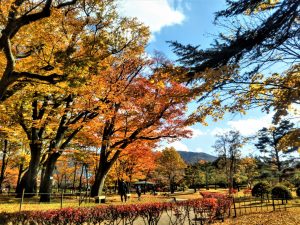
The park is dominated by Zelkova trees (Keyaki), which turn red, Ginko trees (Ichou), which turn a brilliant yellow, and Japanese Horse Chestnut (Tochi-no-ki) which seem to pretty much do whatever they want.
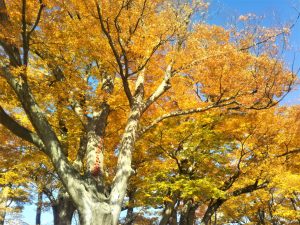
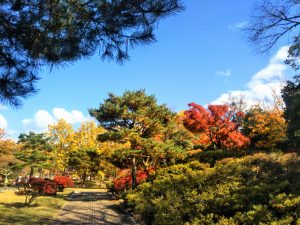
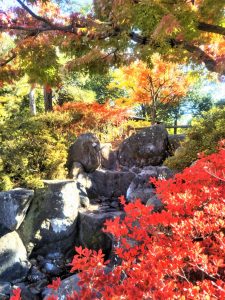
The kids on the playground don’t seem to notice all the color above their little heads. Too distracted.
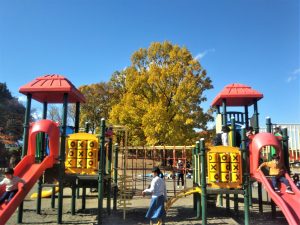
Sadly, I noticed too many of their parents looking down at their phones. A less forgivable distraction.
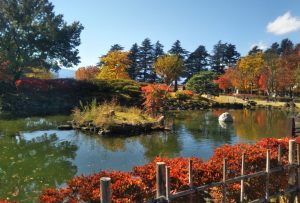
The park seemed sparsely populated, particularly for a holiday (it was Bunka-no-hi – “Culture Day”). On top of this, it was early November and felt like early May. Where was everyone? Shopping? How many more days like this are we going to get in the next eighteen or twenty weeks?
Am I incredulous? Yes. Am I complaining? Heck no. For all of Matsumoto’s allure there never seems to be an overload of people. That’s one of the many things I love about this town.
But back to our walk…
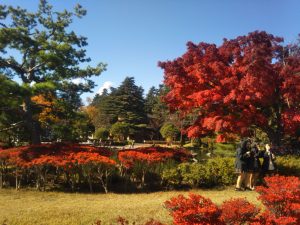
It would only occur to me later that the ongoing pandemic might have something to do with the lack of crowds. But really, I don’t think so. Matsumoto’s visitors don’t tend to make it this far. Which, at the risk of sounding jaded, also adds to the allure of Agata-no-mori.
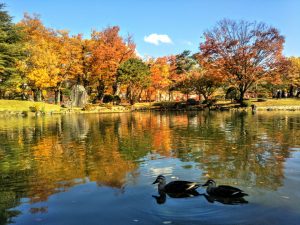
This park is fantastic any time of year. But autumn really does turn this place into something special.
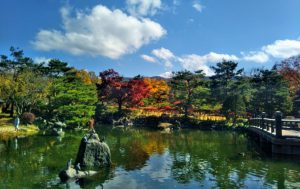
I’ll come back again when Matsumoto gets her first snowfall. The park will surely be beautiful then too.
In an entirely different way.
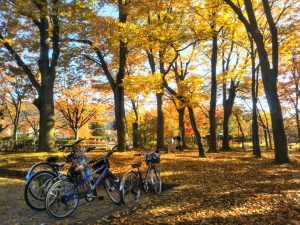
Getting to Agata-no-mori could hardly be easier, but here’s the map anyway:
[googlemaps https://www.google.com/maps/embed?pb=!1m18!1m12!1m3!1d4633.897352922092!2d137.9769984518554!3d36.23207837170538!2m3!1f0!2f0!3f0!3m2!1i1024!2i768!4f13.1!3m3!1m2!1s0x601d0ec1b88c70a9%3A0x540371cb418d2454!2sAgatanomori%20Park!5e0!3m2!1sen!2sjp!4v1604842721210!5m2!1sen!2sjp&w=600&h=450]
While you’re here, duck into one or both of those dull green buildings. They date from the Taisho Era, meaning they were built about a hundred years ago – back when things were made right (whatever that means). They’re cool, in that old-fashioned wood-construction way, and worth checking out.